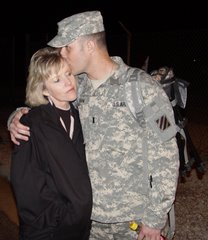By Jim Garamone
American Forces Press Service
WASHINGTON - A 3.4 percent military pay raise, a 2.9 percent civilian raise, money to continue to grow the Army and Marines and a funding increase to maintain readiness are major aspects of the fiscal 2009 defense budget request President Bush sent to Congress today.
The defense budget request is for $515.4 billion – a $35.9 billion increase over the 2008 level. The total federal budget request for fiscal 2009 is $3.1 trillion.
Defense officials said five priorities drive the budget request: winning the war on terror, increasing ground combat capabilities, improving readiness, developing future combat capabilities and improving service members' quality of life.
"The budget request provides the resources needed to prevail in current conflicts, while preparing the department for a range of challenges the nation may face in the years ahead," Defense Secretary Robert M. Gates said during a Pentagon news conference this afternoon.
He pointed out that the defense request amounts to about 3.4 percent of U.S. gross domestic product. "To give you some basis for comparison, ... during the Korean War the percentage of GDP going to defense was about 14 percent, and during Vietnam it was about 9 percent," Gates said.
The budget funds the operations, training, recruiting and equipping of 2.2 million personnel in the Defense Department.
The service portions of the budget are $140.7 billion for the Army, $149.2 billion for the Navy and Marine Corps and $143.8 billion for the Air Force.
The request is broken into four major funding areas: military pay and health care; family housing and facilities; operations, readiness and support; and strategic modernization.
Military pay and health care would receive $149.4 billion, with pay and benefits receiving $107.8 billion and health care $41.6 billion.
Family housing and facilities account for $23.9 billion, with $3.2 billion going to privatizing 12,324 more homes for service members. Base realignment and closure costs are set at $9.5 billion, fully funding 25 base closures and 24 major realignments. The 2009 request also asks Congress to approve $11.2 billion for training centers and base infrastructure needed as the Army and Marine Corps continue to grow.
The budget continues funds for increasing the size of the Army and Marine Corps. Last year, the overall end-strength increase was set at 65,000 soldiers and 27,000 Marines through fiscal 2012.
The budget request asks for $15.5 billion for the Army increase and $5 billion for the Marines in fiscal 2009. If approved, the increase will boost the Army to 532,400 during fiscal 2009 and the number of brigade combat teams from 40 to 42. The Army's goal is a force of 547,400 with 48 brigade combat teams in fiscal 2012.
In fiscal 2009, the Marine Corps will boost its end-strength by 5,000 to 194,000. The Marine goal is 202,000 in fiscal 2011.
The increase will help both services handle the operations tempo required to fight the global war on terrorism, and could potentially mean more time at home for service members. Currently, soldiers deploy to Iraq and Afghanistan for 15-month tours and are at home stations for a year; the Marines are deployed for seven months and home for seven months. Once the growth is finished, soldiers will spend a year deployed and two years at home station, and the Marines will deploy for seven months and be home for 14 months.
Air Force end-strength will be set at 316,600, and Navy end-strength will be 325,300.
Force readiness will experience a 10.4 percent jump in funding over 2008 if the budget is approved. The budget request is $158.3 billion, an increase of $14.9 billion. Operational readiness – tank miles, ship steaming days and flying hours – will remain constant, officials said.
The request also includes $33.1 billion for logistical, intelligence and servicewide support activities. Equipment maintenance is set at $11.8 billion, while base operations and facilities maintenance are pegged at $32.6 billion for more than 5,300 sites worldwide. Training is set for $7.4 billion, and recruiting is at $3.3 billion for fiscal 2009.
Strategic modernization is set at $183.8 billion in fiscal 2009, up $10.5 billion from fiscal 2008. The category includes procurement and research and development. Joint air capabilities account for about half of the procurement, and includes 16 F-35 Joint Strike Fighters, 20 F-22A Raptors, 36 V-22 Ospreys, 23 F/A-18 Hornets, 16 CH-47 Chinook helicopters and $1.4 billion for the Air Force's KC-X tanker aircraft program.
On the Navy side, the budget includes money for building the CVN-21 aircraft carrier, a Virginia-class submarine, two littoral combat ships and a DDG-1000 destroyer.
Army buys include 119 Stryker vehicles, 5,249 Humvees, 29 M-1A1 tank upgrades, 1,061 heavy tactical vehicles and 3,187 medium tactical vehicles.
Spec-based capabilities include more launch vehicles, two space-based infrared systems and advanced, extremely high-frequency satellite and ballistic missile defense.
Officials said the department will work with Congress to ensure four specific initiatives mentioned in the president's State of the Union address become realities. The first is to put legislation in place so service members can transfer unused education benefits to spouses or children. The second is to expand and strengthen career opportunities for military spouses. Third is to develop a public-private partnership to increase child-care centers in communities surrounding military bases. The last is to implement the Dole-Shalala Report recommendations for treatment of wounded warriors and their families.
Monday, February 4, 2008
Subscribe to:
Post Comments (Atom)





No comments:
Post a Comment